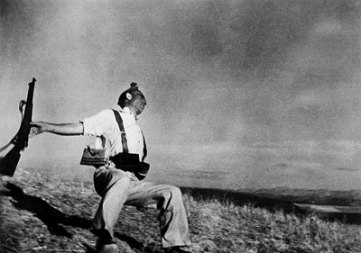
Ruth Orkin, Robert Capa in a Café, Paris, France, 1952. © Photograph of Robert Capa by Ruth Orkin
That's his face above. And it is quite a face. From the wild bohemian boy to the smoothie with the thick brows and the James Bond smile set to 'quizzical'. A handsome rogue.
Speaking personally I don't think it's the worst thing to be - a handsome rogue, that is - and if I had been granted the necessary equipment in terms of features I might have tried to make a go of it. But then he was a brave and handsome rogue, and that is a more challenging package.
'So what's this photography lark like?' he asks the already established photographer, Eva Besnyö in Germany in 1931 or so. She tells him it's not a lark but a profession. He flits around, gets himself a job at a photographer's and learns the craft, then tries to set up as a professional himself. At that stage he is still Endre or André Friedmann, a Budapest-born Jewish boy who studied politics. He is ultra easy-going and jokes all the time, quickly charming even those who tend to be suspicious of precisely such untrustworthy characters. He gambles too. He gets his first break in Denmark after hearing Trotsky is in Copenhagen to deliver a speech, and while all the photographers are elsewhere he snaps the famous man in action and sells the pictures. At last he is a photographer. But it's still difficult. Then, in Paris, he meets a very beautiful young refugee from Leipzig called Gerta Pohorylle who acts as his entrepreneur. They both change their names. She to Gerda Taro, photographer, and he to Robert Capa. That's about 1936.
Soon he is off. He photographs the protests of the Front Populaire. Spain next, the Civil War, where he takes that famous picture on 5 September 1936 of the first victim of battle. This one:

Today there are all kinds of controversy as to whether it is a set up, a pose. If not, he is very close indeed. 'If it's not good enough that's because you're not close enough' he says. (There are more photos in the series of the dead Republican soldier, complete with name.) The rest, as they inevitably say, is history, or at least war history. He becomes the man to send to the next war zone. He lives it up and takes the chances. Inevitably perhaps, in the end, he steps on a landmine in Indo-China and is killed instantly. It is April 1954, just a couple of years after the top photo was taken. In the meantime there is Picasso and Matisse and Steinbeck, Normandy, Stalingrad etc.
*
I said I enjoyed the other photographic show more, but that is primarily for three reasons. Firstly, because I knew the work there rather less well than I know Capa's; secondly, because Capa's work is either war or cultural glamour, which is exciting but restricted; and thirdly, because, in some ways, the Alan Sekula view stands up rather better here. Not, I should hasten to add, because of Capa himself, but because of Capa's aura. He was not unwilling to cultivate an aura himself of course, albeit in a playful Humphrey Bogartish sort of way. It is, rather, the aura or glamour of early death. It is therefore not unnatural to say:' This scene is from such and such a period of Capa's life' rather than: 'This picture shows...'
Aura is a Walter Benjamin term used to define the alluring power of unique objects in an age of mechanical reproduction. Capa is himself the unique object in this case. He is unique in that what we know about him is a function of uniqueness. He is a myth, an icon, what you will. He looks at you a little cynically. Under his breath he is saying something like "We will always have Paris." Adding, "Or Berlin, or London, or Budapest, or Barcelona, or..." So the dying Republican soldier is part of Capa's story. Or also Capa's story. It would be hard for him to be entirely his own story now.
The Crisis exhibition showed people in unheightened states. They were ordinary days when people were doing tough, demeaning, boring ordinary things. No great event had overtaken them. Nothing haloed their worn bodies. They were simply a part of the vast and complex day, a day when other might have been listening to a choir or chamber concert at the great palace in Gödöllö where we called yesterday, or moving just that bit closer to the sniper for the sake of that better (no pun) shot. Some words on Gödöllö maybe later.

No comments:
Post a Comment